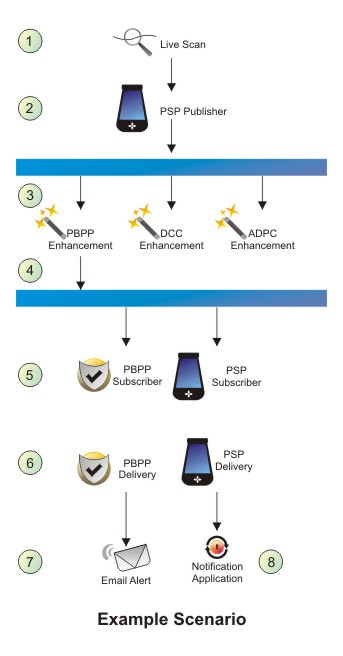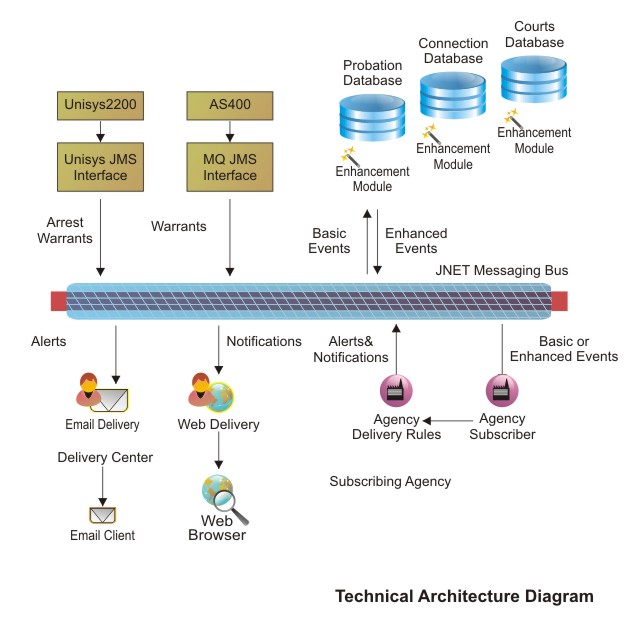Government and Defense – JNET
 View as PDF
View as PDF
Commonwealth of Pennsylvania uses Fiorano's solution to enhance public safety in the state by enabling real time exchange of criminal justice information between participating law enforcement agencies.

Business Problem
The goal of the Pennsylvania Justice Network (JNET) was to provide a common on-line environment whereby authorized state, county and local officials could access offender records and other justice information from participating agencies. The JNET System serves as a platform for broad-based knowledge sharing among its users. JNET started as a system based in partnering agencies at the state level, but now it is growing toward a full partnership with county governments as well as municipalities, local police departments and federal agencies.
The JNET System operates through a secure statewide Extranet specifically designed for the administration of justice. It provides a single interface to offender information at multiple agencies and a mechanism for publishing information and accessing JNET resources. Each agency retains complete control over the information it shares and who has access to specific data.
- Build a messaging infrastructure (MI) to support distributed applications spanning multiple agencies, including Notifications and other applications.
- The MI must provide a means for different agency systems running on different platforms at different locations to communicate with each other.
- The MI must be fully secure, 100% reliable (no dropped messages) and robust.
- The MI should be standards based.
An automated system was required to prevent this from occurring. Thus the Business Requirement became: Provide a Notifications System to notify law enforcement officials of key events e.g. Escapes, Warrants, Wants (Wanted Persons), Arrests, with at least the following features:
- All Vital data stored/produced in geographically dispersed locations e.g. Arrests are at State Police, Probationer/Parole status stored at Department of Probation need to be pulled together on demand.
- Agencies have the flexibility to determine locally which users receive which notifications.
- Notifications should be sent by e-mail, fax, pager, web, and subscriptions should be configurable by users.
- All data transmissions are encrypted, and all users accessing the system are authenticated.
The diagram below illustrates a real-life example on some of the issues that Commonwealth of Pennsylvania wanted to solve within the JNET Project. The problem involved four state agencies: the Pennsylvania State Police (PSP), the Department of Corrections (DOC), Pennsylvania Board of Pardons (PBPP), and the AOPC.

FIGURE 1: Real life issue pre-implementation
- The offender is arrested for some reason, and is fingerprinted by police on a Live Scan machine.
- The Live Scan machine immediately communicates with PSP and National systems, creating an arrest record. PSP 'publishes' this arrest record on the JNET Network.
- PBPP, DOC, BOP, AOPC Subscriber Modules each receive the arrest from PSP. The module at each agency checks that agency's database to determine the status of the offender.
- In this example, lets say that the offender is found in the PBPP database, listed as being on Parole. PBPP then 'publishes' a new event, containing the information about the arrest and the fact that the offender is on parole.
- Any agency may have chosen to subscribe to this event. For this example, lets assume that PBPP and PSP have subscribed to 'Arrests of Parolees'. Subscriber modules at PBPP and PSP therefore pick up the event.
- The subscriber modules pass the events to the delivery modules, which then send out the Notification to particular users, based on each agency's requirements. In addition, email alerts can also sent out to each user.
- The appropriate users receive an email or page notifying them of the arrest.
- The user then checks the Notifications Application Web page to view more details of the Notification, and acts accordingly
Solution
KPMG Consulting Services (now Bearing Point Inc.) was engaged by the Commonwealth of Pennsylvania to develop numerous applications for all the justice related agencies, this initiative was entitled The 'JNET' Project JNET's mandate was to provide various applications enabling the sharing on data across justice related agencies e.g. State Police, Department of Probation, Department of Corrections, Board of Pardons, and Courts etc.

FIGURE 2: Application architecture for JNET using FioranoMQ

 World Wide Support
World Wide Support